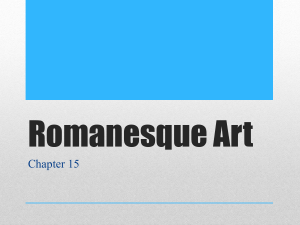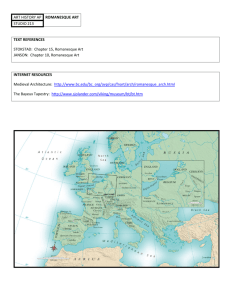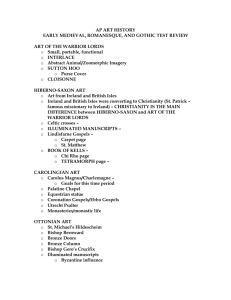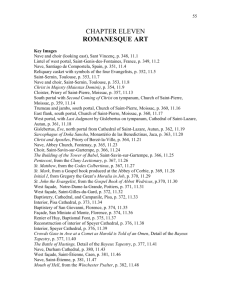Gardner’s Art Through the Ages, 13e Chapter 17 Romanesque Europe
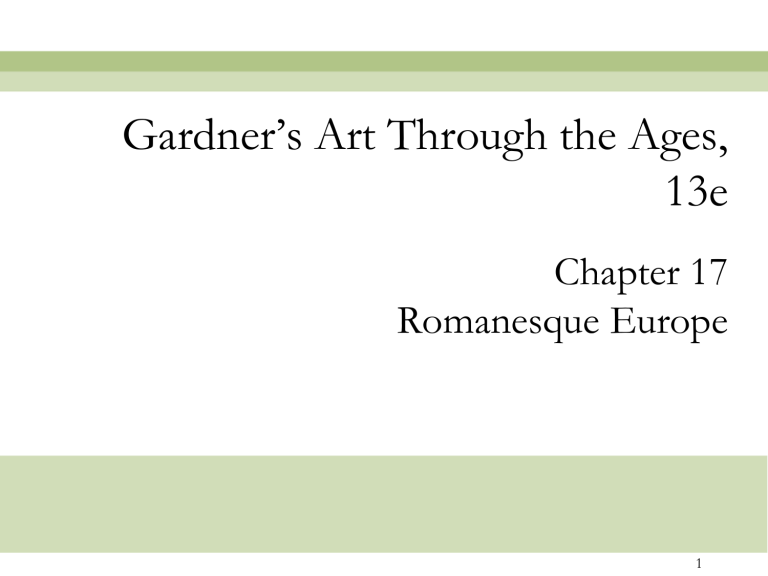
Gardner’s Art Through the Ages,
13e
Chapter 17
Romanesque Europe
1
Europe About 1100
2
Important Elements of
Romanesque Architecture
SEEK the following Romanesque architectural features:
Using Chapter 17 of your textbook, identify your selected vocabulary word in as many images (figures) as you can.
• 1. Ambulatory –
17-3, 17-5, 17-7, 17-8, 17-19, 17-20 17-31, 17-32, 17-33, 17-34 = 10
• 2. Radiating chapels –
17-3, 17-5, 17-8 = 3
• 2. Portal and its parts –
• 3. Nave, transept, and side aisles -
• 4. Cruciform -
17-1, 17-10, 17-11, 17-12, 17-13, 17-25, 17-30 = 7
17-4, 17-5, 17-8, 17-33, 17-34 = 5
17-3, 17-5, 17-8, 17-14, 17-16, 17-19, 17-27,
17-31, 17-32, 17-33, 17-34 = 11
• 4. Crossing -
• 5. Bays -
17-4, 17-5, 17-6, 17-8, 17-34 = 5
17-5, 17-6, 17-14, 17-16, 17-19, 17-21, 17-27, 17-31, 17-32, 17-33, 17-34 = 11
• 6. Gallery/ tribune level -
• 6. Cloister -
17-9, 17-20 =2
17-21, 17-31, 17-33 = 3
• 6. Clerestory -
• 7. Barrel vault -
17-2, 17-4, 17-5, 17-8, 17-19 = 5
17-8, 17-14, 17-16, 17-27 = 4
• 7. Groin vault -
17-5, 17-19, 17-31, 17-32, 17-33, 17-34 = 6
3
11 important aspects of Romanesque architecture
1.
2.
3.
4.
5.
“Romanesque” is the first international style since the
Roman Empire. Also known as the “Norman” style in
England
Competition among cities for the largest churches, which continues in the Gothic period via a “quest for height.”
Masonry (stone) the preferred medium. Craft of concrete essentially lost in this period. Rejection of wooden structures or structural elements.
East end of church the focus for liturgical services. West end for the entrance to church.
Church portals as “billboards” for scripture or elements of faith.
6.
Cruciform plans. Nave and transept at right angles to one another. Church as a metaphor for heaven.
7.
8.
Elevation of churches based on basilican forms, but with the nave higher than the side aisles.
Interiors articulated by repetitive series of moldings. Heavy masonry forms seem lighter with applied decoration.
9.
Bays divide the nave into compartments
10.
Round-headed arches the norm.
11.
Small windows in comparison to buildings to withstand weight
This church was first constructed in the honor of the city’s first bishop, Saint Saturninus
(Saint Sernin in French), who was martyred in the middle of the third century.
This church served as an important stop for pilgrims traveling to Santiago de Compostela in northwestern Spain.
Pilgrims would flock to this church by the masses, and the church had been designed specifically to accommodate them.
The plan of this church closely resembles that of Santiago de Compostela’s and Saint Martin at Tours and exemplifies what has come to be called the “ pilgrimage type
”
These are some features present: radiating chapels ambulatory transept upper galleries (tribunes) large nave
The Saint- Sernin design is extremely regular and geometrically precise. The crossing square, flanked by massive piers and marked off by heavy arches, served as the module for the entire church.
Each nave by measures exactly one-half of a crossing square, and each aisle bay measures exactly one-quarter.
SERNIN
Aerial view (southeast) of Saint-Sernin,
Toulouse, France ca 1070-1120
1. St.-Sernin has been called a “pilgrimage” type church. What accounted for this designation?
2. What are the characteristics of a “pilgrimage” church?
SERNIN
Figure 17-5 Plan of Saint-Sernin, Toulouse, France, ca. 1070-1120 (after Kenneth John
Conant). 6
SERNIN
Figure 17-6 Interior of Saint-
Sernin, Toulouse, France, ca.
1070-1120.
7
Christ sits in a mondorla (a medieval
Christian artistic convention by which an oval or almond-shaped area or series of lines surrounds a deity, most commonly Jesus.) his right hand raised in blessing, his left hand resting on an open book inscribed with the words “Pax vobis” (”peace be unto you”).
The signs of the Four Evangelists occupy the slab’s corners. Above are the eagle of Saint
John and the angel of Saint Matthew. Below are the ox of Saint Luke and the lion of Saint
Mark.
Bernardus Geldunius
Christ in Majesty
Saint-Sernin, Toulouse, France, ca
1096
Diagram of a
Romanesque
Portal
Figure 17-10 The Romanesque church portal.
9
Christ in
Majesty with angels and the
24 elders tympanum of south portal of
Saint- Pierre
Moissac,
France, ca 1115-
1135
(the Last Judgment).
eagle, ox
|
angel, lion
.
attendant angel holding scrolls to record human deeds for judgment
Twenty-Four Elders who accompany Christ as the kings of this world and make music in his praise.
Two courses of wavy lines symbolizing the clouds of Heaven divide the Elders into three tiers.
One of the largest in
Europe until the new St.
Peter’s in Rome was
Constructed in the 17 th century.
CLUNY III
The pointed arch was a structural device would permit later architects
(Gothic period) to increase the height of the nave dramatically. Pointed arches transfer the thrust of the vaults more directly downward to the piers and require less buttressing on the sides
Figure 17-8 Restored cutaway view of the third abbey church (Cluny III), Cluny, France, 1088-1130
(John Burge).
11
SPEYER
Figure 17-19 Interior of
Speyer Cathedral, Speyer,
Germany, begun 1030; nave vaults, ca. 1082–1105.
12
ETIENNE
Architecture Figure 17-30 West facade of Saint-
Étienne, Caen, France, begun 1067.
DURHAM
How did 11th century
Romanesque masons construct monumental groin vaults?
http://www.durhamcathedral.co.uk/history
Figure 17-33 Interior (left) and lateral section (right) of Durham Cathedral,
England ,begun ca.1093.
14
ITALIAN ROMANESQUE
PISA
Figure 17-25 Cathedral complex, Pisa, Italy; cathedral begun 1063; baptistery begun 1153; campanile begun 1174.
VOCAB IDENTIFICATION
http://www.sacred-destinations.com/italy/pisa-baptistery
Figure 17-26 Baptistery of San
Giovanni, Florence, Italy, dedicated 1059.
It is said this structure’s design is simple and serenely classical. It is a descendant of the
Pantheon and the
Early Christian Sta.
Costanza.
What structure is being described?
Figure 17-26 Baptistery of San Giovanni,
Florence, Italy, dedicated 1059. 19
The Romanesque church that had a wooden ceiling like those found in Early
Christian basilicas was???
Figure 17-27 Interior of
San Miniato al Monte,
Florence, Italy, ca. 1062–
1090.
20
faithful of Original Sin and that the path to salvation is
THAT IS DISTINCTLY
matter of the frieze?
ROMANESQUE:
mondorla
Figure 17-28 WILIGELMO, creation and temptation of Adam and Eve, detail of the frieze on the west facade, Modena Cathedral, Modena, Italy, ca. 1110. Marble, 3’ high. 21
Figure 17-11 Lions and Old Testament prophet (Jeremiah or Isaiah?), trumeau of the south portal of Saint-Pierre, Moissac,
France, ca. 1115–1130.
22
Gislebertus,
Last Judgement
Saint-Lazzare, Autun, France ca 1120-1135
The Blessed
&
The Damned
What was the essential core value of the work of
Romanesque artists, whether they were anonymous or recognized?
Figure 17-23 RAINER OF HUY, baptism of Christ, baptismal font from Notre-Damedes-Fonts, Liège, Belgium, 1118. Bronze, 2’ 1” high. Saint-Barthélémy, Liège.
25
Figure 17-18 Virgin and
Child (Morgan Madonna), from the Auvergne, France, second half of twelfth century.
Painted wood, 2’ 7” high.
Metropolitan Museum of Art,
New York (gift of J. Pierpont
Morgan, 1916).
26
Head reliquary of Saint Alexander Stavelot Abbey, Belgium ca 1145
“(Men’s) eyes feasted with relics cased in gold, and their purse-strings are loosened. They are shown a most comely image of some saint, whom they think all the more saintly that his is the more gaudily painted. Men run to kiss him, and are invited to give; there is more admiration for his comeliness than veneration for his sanctity.....O vanity of vanities, yet no more vain than the insane! The church.... clothes her stones in gold and leaves her sons naked: the rich man’s eye is fed at the expense of the indigent. The curious find delight here, yet the needy find no relief. “
Saint-Savin is a hall church with paintings on the continuous vault of the nave. Which of the following allows for this?
Figure 17-16 Nave (left) and painted nave vault
(right) of the abbey church, Saint-Savin-sur-
Gartempe, France, ca. 1100.
28
ROMANESQUE VS. MEDIEVAL
Figure 17-37 EADWINE THE SCRIBE,
Eadwine the scribe at work, folio 283 verso of the Eadwine Psalter, ca. 1160–1170. Ink and tempera on vellum. Trinity College,
Cambridge.
29
NARRATIVE IN ART
VIOLENCE IN ART
The Bayeux Tapestry is unique in Romanesque in that it depicted an actual event in full detail shortly after it occurred.
http://www.hastings1066.com/
Figure 17-35 Funeral procession to Westminster Abbey (top) and Battle of Hastings
(bottom), details of the Bayeux Tapestry, from Bayeux Cathedral, Bayeux, France, ca. 1070-
1080. Embroidered wool on linen, 1’ 8” high (entire length of fabric 229’ 8”). Centre
Buillaume le Conquerant, Bayeux.
30
ENGLISH ROMANESQUE
Durham Cathedral
Canterbury Cathedral

